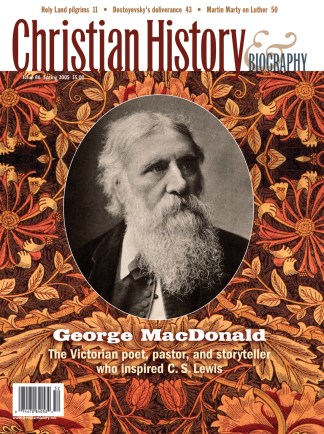First Church of Norway?
The story of the conversion of Norway’s Vikings has long focused on how the country’s kings converted to Christianity, then ordered their subjects to, as King Olaf Trygvesson put it in A.D. 996, “Be Christian or die.” (See Issue 63: Conversion of the Vikings.)
But new radiological dating of a stave church site, first unearthed in 2001, may change that story significantly. Archaeologists say the church in Skien (the birthplace of playwright Henrik Ibsen, about 70 miles southwest of Oslo) was built between A.D. 1010 and 1040, after the deaths of Christian kings Olaf Trygvesson (d. 1000) and the canonized Olaf Haraldsson (d. 1030). But two Christian graves at the site date between 885 and 990, which (along with some other findings) University of Oslo medievalist Jon Vidar Sigurdsson says would push the date of Norway’s conversion to the 800s, not the turn of the millennium. Jan Brendalsmo, archaeologist for the Foundation for Cultural Heritage Research agrees. “It is fun to see confirmation of what we have long believed, that there was a Christianization of Norway long before the two Olavs came,” he told the newspaper Aftenposten.
CSI: Christ Scene Investigation
At last: a Da Vinci mystery that has nothing to do with Dan Brown. Art historians agree that the Tondo (round) painting of the Adoration of the Christ Child, on display at Rome’s Galleria Borghese, is one of the finest Renaissance oil paintings of its kind. What they haven’t agreed on is its artist. Since the 1790s, historians have attributed it to Raphael, Ghirlandaio, Lorenzo di Credi, and others. Since 1926, Fra Bartolomeo’s name has been on the adjoining plaque. Others, however, have speculated that Leonardo da Vinci may have had a hand. A hand indeed: Restorers have uncovered in the painting that most archetypical of clues, a fingerprint. “I wouldn’t have found it if I hadn’t been using my microscope,” Elizabetta Zatti told The Guardian. “It’s clearly a fingerprint left while the paint was still wet, but we don’t really know whose finger it belongs to.” But they have a good guess: Leonardo deliberately left fingerprints in some works as a signature of sorts, and some of the techniques and colors in the painting match his style. Researchers are now comparing the print with one on Leonardo’s Lady with an Ermine, in Krakow, Poland.
St. Peter’s in Miniature
St. Peter’s Basilica was no easy destination this spring, as hundreds of thousands of pilgrims traveled to Vatican City to pay their last respects to Pope John Paul II. Americans preferring to stay stateside but still see the interior of the grand church while honoring the late pope have a rare opportunity to do so: The Pope John Paul II Cultural Center in Washington, D.C., happened to be exhibiting Michelangelo’s original 18-foot-tall wooden model of the basilica dome as part of a large exhibit on the creation of the church. The model continues to be used when repair or restorations are needed on the actual church, and Michelangelo himself condemned builders for being less careful in their construction than he was in making the model. “The model, such as I make for everything, was exact,” he scolded in a 1557 letter. The exhibit will be in Washington, D.C., through May 31, 2005, then travels to Germany.
Cradle of Scottish Christianity
Ninian may not have been the first to take the gospel to the Picts in what is now Scotland, but he’s the first to get credit for it. His stone church in what is now Whithorn was named Candida Casa, the white house, because the locals had never seen such a structure before. It became a major monastic center, drawing students from Ireland and Wales, but the white walls eventually crumbled.
Today the island of Iona, founded a century after Whithorn by Columba, is the primary destination for pilgrims with Celtic Christianity on their minds. But on Good Friday, a significantly renovated Whithorn site opened, and tourists can visit the remains of the 12th-century priory built on Candida Casa’s foundation. The site also has a signficant collection of 60 carved stones (including the Latinus Stone, the oldest Christian stone carving in Scotland, which dates to about 450).
Petra: Lost City of Stone
Petra, a city carved by Nabataeans out of sandstone cliffs about 48 miles south of the Dead Sea before the time of Christ, has been a popular tourist site since its rediscovery in 1812. Now the ancient city-or at least 200 important artifacts from it-are slowly touring North America. “Petra: Lost City of Stone,” is presently at Calvin College, in Grand Rapids, Michigan, until August 15. (From there, it’s off to Calgary and Ottawa.) The Calvin display has drawn attention to Petra’s Christian history-one of the most prominent artifacts is a pieced-together marble pulpit from the Byzantine-era “Blue Chapel,” which demonstrates that Christians thrived at the site even after an earthquake struck it in 363. Records show bishops from Petra attending early church councils such as the Council of Sardica in 343. Athenogenes, bishop of Petra in the late 500s, is the last recorded Christian leader of the city, once home to more than 20,000.
Santa Claus Is Coming to Town
The original Saint Nicholas has been spurned by his own hometown. The city he served as bishop, Myra, in Lycia, is now the Turkish city of Demre. And on February 3, the city council voted to replace the town center’s traditional bronze statue of Nicholas in a brightly colored effigy of a fat man with a red fur suit: the Nicholas imposter, Santa Claus (a perversion of the Dutch name for Nicholas, Sante Klaas). “The current statue is the best way to introduce Saint Nicholas because the whole world knows this image of him in his red clothes and hat, with his sack of presents and a bell in his hand,” Mayor Suleyman Topcu told Reuters. He told the Chicago Tribune, “This is the one everyone knows. We couldn’t figure out what the other one is.” Locals (overwhelmingly Muslim) supported the move, saying, “The other was a priest, a Christian.” Tour guides, historians, and others, however, have begged the council to change its mind.
Silver Scrolls Are Older than Qumran’s
In 1979, Israeli archaeologist Gabriel Barkay found two silver scrolls in a Jerusalem tomb. “May the Lord bless you and keep you,” they said, quoting the Book of Numbers. “May the Lord make his face to shine upon you.” Yet the inscriptions were difficult to make out. Using sophisticated computer photo imaging, Bruce Zuckerman, associate professor of Hebrew Bible at the University of Southern California, has confirmed Barkay’s dating the scrolls to the 7th century B.C., or four centuries older than the Dead Sea Scrolls. “This was quite a remarkable thing, making these the oldest artifacts ever discovered that quote texts that we find in the Bible,” Zuckerman told Voice of America. “This is like Godzilla meets King Kong.” A previously unseen section of the scrolls, revealed only through a special photographic lighting technique, refers to God as the “rebuker of evil.” Zuckerman believes the scroll was worn as a kind of amulet. High-resolution photos of the scrolls are available through The Bulletin of the American Schools of Oriental Research.
Copyright © 2005 by the author or Christianity Today/Christian History & Biography magazine.Click here for reprint information on Christian History & Biography.










